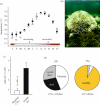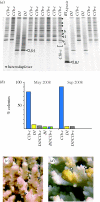Host-symbiont recombination versus natural selection in the response of coral-dinoflagellate symbioses to environmental disturbance
- PMID: 20444713
- PMCID: PMC2982020
- DOI: 10.1098/rspb.2010.0385
Host-symbiont recombination versus natural selection in the response of coral-dinoflagellate symbioses to environmental disturbance
Abstract
Mutualisms between reef-building corals and endosymbiotic dinoflagellates are particularly sensitive to environmental stress, yet the ecosystems they construct have endured major oscillations in global climate. During the winter of 2008, an extreme cold-water event occurred in the Gulf of California that bleached corals in the genus Pocillopora harbouring a thermally 'sensitive' symbiont, designated Symbiodinium C1b-c, while colonies possessing Symbiodinium D1 were mostly unaffected. Certain bleached colonies recovered quickly while others suffered partial or complete mortality. In most colonies, no appreciable change was observed in the identity of the original symbiont, indicating that these partnerships are stable. During the initial phases of recovery, a third species of symbiont B1(Aiptasia), genetically identical to that harboured by the invasive anemone, Aiptasia sp., grew opportunistically and was visible as light-yellow patches on the branch tips of several colonies. However, this symbiont did not persist and was displaced in all cases by C1b-c several months later. Colonies with D1 were abundant at inshore habitats along the continental eastern Pacific, where seasonal turbidity is high relative to offshore islands. Environmental conditions of the central and southern coasts of Mexico were not sufficient to explain the exclusivity of D1 Pocillopora in these regions. It is possible that mass mortalities associated with major thermal disturbances during the 1997-1998 El Niño Southern Oscillation eliminated C1b-c holobionts from these locations. The differential loss of Pocillopora holobionts in response to thermal stress suggests that natural selection on existing variation can cause rapid and significant shifts in the frequency of particular coral-algal partnerships. However, coral populations may take decades to recover following episodes of severe selection, thereby raising considerable uncertainty about the long-term viability of these communities.
Figures




Similar articles
-
Long-range dispersal and high-latitude environments influence the population structure of a "stress-tolerant" dinoflagellate endosymbiont.PLoS One. 2013 Nov 5;8(11):e79208. doi: 10.1371/journal.pone.0079208. eCollection 2013. PLoS One. 2013. PMID: 24223906 Free PMC article.
-
Transcriptional response of two core photosystem genes in Symbiodinium spp. exposed to thermal stress.PLoS One. 2012;7(12):e50439. doi: 10.1371/journal.pone.0050439. Epub 2012 Dec 7. PLoS One. 2012. PMID: 23236373 Free PMC article.
-
New insights into the dynamics between reef corals and their associated dinoflagellate endosymbionts from population genetic studies.Mol Ecol. 2014 Sep;23(17):4203-15. doi: 10.1111/mec.12788. Epub 2014 Jun 9. Mol Ecol. 2014. PMID: 24909707
-
Coral Symbiodinium Community Composition Across the Belize Mesoamerican Barrier Reef System is Influenced by Host Species and Thermal Variability.Microb Ecol. 2018 May;75(4):903-915. doi: 10.1007/s00248-017-1096-6. Epub 2017 Nov 2. Microb Ecol. 2018. PMID: 29098358
-
Genotypic diversity and spatial-temporal distribution of Symbiodinium clones in an abundant reef coral.Mol Ecol. 2011 Dec;20(24):5197-212. doi: 10.1111/j.1365-294X.2011.05357.x. Epub 2011 Nov 14. Mol Ecol. 2011. PMID: 22082053 Free PMC article.
Cited by
-
Diversity and distribution of Symbiodiniaceae detected on coral reefs of Lombok, Indonesia using environmental DNA metabarcoding.PeerJ. 2022 Oct 24;10:e14006. doi: 10.7717/peerj.14006. eCollection 2022. PeerJ. 2022. PMID: 36312748 Free PMC article.
-
Heritable differences in fitness-related traits among populations of the mustard hill coral, Porites astreoides.Heredity (Edinb). 2015 Dec;115(6):509-16. doi: 10.1038/hdy.2015.52. Epub 2015 Jun 17. Heredity (Edinb). 2015. PMID: 26081798 Free PMC article.
-
Host transcriptomic plasticity and photosymbiotic fidelity underpin Pocillopora acclimatization across thermal regimes in the Pacific Ocean.Nat Commun. 2023 Jun 1;14(1):3056. doi: 10.1038/s41467-023-38610-6. Nat Commun. 2023. PMID: 37264036 Free PMC article.
-
Calcification and growth rate recovery of the reef-building Pocillopora species in the northeast tropical Pacific following an ENSO disturbance.PeerJ. 2017 Apr 11;5:e3191. doi: 10.7717/peerj.3191. eCollection 2017. PeerJ. 2017. PMID: 28413732 Free PMC article.
-
Limited phosphorus availability is the Achilles heel of tropical reef corals in a warming ocean.Sci Rep. 2016 Aug 17;6:31768. doi: 10.1038/srep31768. Sci Rep. 2016. PMID: 27531136 Free PMC article.
References
-
- Adl S. M., et al. 2007Diversity, nomenclature, and taxonomy of Protists. Syst. Biol. 56, 684–689 (doi:10.1080/10635150701494127) - DOI - PubMed
-
- Baird H. A., Bhagooli R., Ralph P. J., Takahashi S.2009Coral bleaching: the role of the host. Trends Ecol. Evol. 24, 16–20 (doi:10.1016/j.tree.2008.09.005) - DOI - PubMed
-
- Baker A. C.2001Reef corals bleach to survive change. Nature 411, 765–766 (doi:10.1038/35081151) - DOI - PubMed
-
- Baker A. C.2003Flexibility and specificity in coral-algal symbiosis: diversity, ecology, and biogeography of Symbiodinium. Annu. Rev. Ecol. Evol. Syst. 34, 661–689 (doi:10.1146/annurev.ecolsys.34.011802.132417) - DOI
-
- Baker A. C., Starger C. J., McClanahan T. R., Glynn P. W.2004Corals' adaptive response to climate change. Nature 430, 741 (doi:10.1038/430741a) - DOI - PubMed
Publication types
MeSH terms
LinkOut - more resources
Full Text Sources

